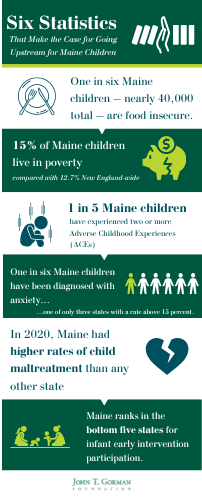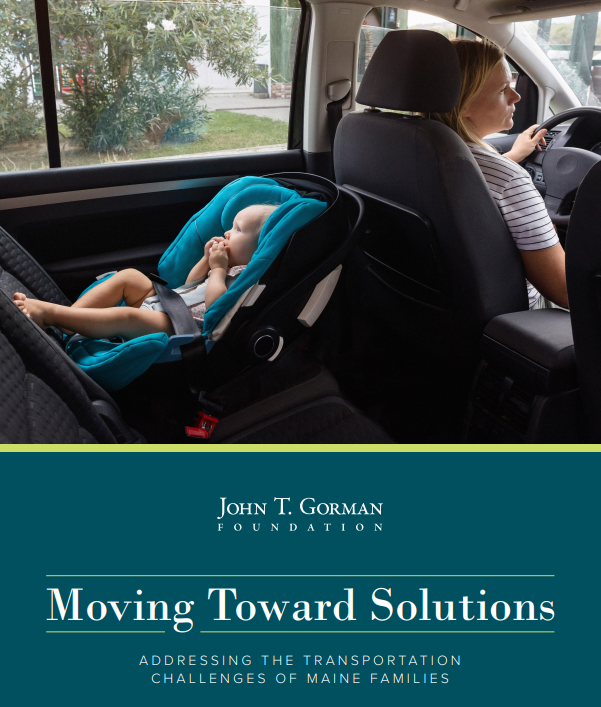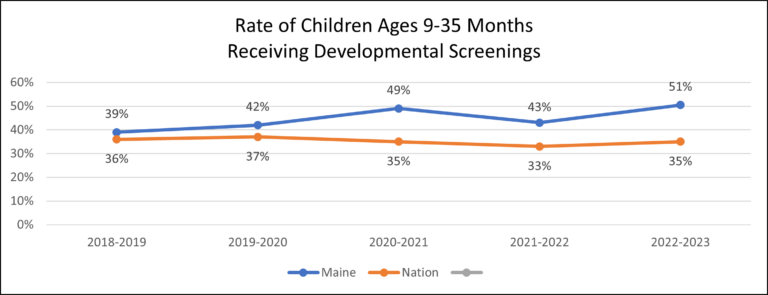
Many factors went into the John T. Gorman Foundation’s decision to focus our work more intensively on Maine children over the next five years, but nothing was more compelling than the data on the well-being of Maine kids.
As part of our strategic planning process, we took a deep dive into statewide population, economic, and health data to find the areas of greatest need. We also analyzed where we could best apply our resources to achieve the greatest impact. While we found significant needs across all age groups, the situation faced by Maine children was most concerning.
Across many measures, Maine children face more difficult challenges than their peers in New England and across the nation. Far too many children experience poverty, food insecurity, anxiety, neglect and other issues that can have lifelong impacts. These challenges make it harder to successfully transition to adulthood, graduate from high school or college and secure a job paying a livable wage – which has implications for families, and our entire state’s workforce, economy, and future.
Among many others, the six statistics below make a compelling case for directing more of our efforts upstream. By working with partners to focus on the well-being and resiliency of Maine children and their families, we believe we can help improve the lives of more Maine people.
STATISTIC: 1 in 6 Maine children – nearly 40,000 in total – are food insecure. These rates vary regionally: five Maine counties have child food insecurity rates above 20%.
WHY IT’S IMPORTANT: Food insecurity has significant and enduring adverse effects on children’s academic, cognitive, and behavioral outcomes. Food insecurity impacts child development through multiple pathways, including by depriving children of the types and quantities of food needed for healthy physical growth, but also by triggering heightened stress and anxiety among their caregivers that affect positive parenting practices.
STATISTIC: 15% of Maine children live in poverty. This rate is higher than New England’s average of 12.7%. Rates also vary regionally, climbing as high as 22% in Washington County.
WHY IT’S IMPORTANT: Growing up in poverty is strongly linked with Adverse Childhood Experiences (ACEs) that can have lifelong consequences. In other words, the effects of childhood poverty don’t end in childhood. Children experiencing poverty are more likely to experience challenging outcomes in adulthood compared to children growing up in higher-income households, including less education completion, lower-incomes, and poor health outcomes. Poverty that is deep, occurring early in childhood, or enduring for multiple years is associated with the most serious adverse impacts.
STATISTIC: 1 in 5 Maine children have experienced two or more ACEs, compared with 17 percent nationwide.
WHY IT’S IMPORTANT: The Center for Disease Control and Prevention states that the toxic stresses associated with ACEs (such as child abuse, neglect, and exposure to violence) shape brain development and are linked with increased risk of chronic health conditions, mental health issues, and substance misuse in adulthood. These risks are compounded as children experience additional ACEs.
STATISTIC: One in six Maine children have been diagnosed with anxiety – one of only three states with a child anxiety rate above 15 percent.
WHY IT’S IMPORTANT: The American Academy of Child and Adolescent Psychiatry links untreated childhood anxiety with long-term challenges, including inability to make friends, low self-esteem, and academic difficulties.
STATISTIC: Maine has the highest child maltreatment rate in the nation. Between 2016 and 2020, the rate of substantiated cases of abuse and neglect jumped from 13.5 to 19 per 1,000 children.
WHY IT’S IMPORTANT: The social and economic costs of child maltreatment are complex, ranging from trauma and physical injury to direct costs for the medical treatment of injuries and foster care placements, as well as long-term costs, like higher risk of mental health problems in adulthood. Calculations using just substantiated cases (likely an undercount of true prevalence) suggest that the costs associated with the maltreatment of nearly 3,500 unique victims in Maine in 2018 will reach $2.9 billion over their lifetimes.
STATISTIC: Maine ranks in the bottom five states for the rate of infants receiving early intervention services.
WHY IT’S IMPORTANT: Early childhood interventions – such as screenings for developmental delays and disabilities, and associated services that can have a significant impact on a child’s ability to learn new skills and overcome challenges – can be critical to a child’s future. Moreover, national early childhood experts suggest that these interventions are most impactful and cost-effective when provided earlier in life, when the developing brain is malleable and forming the foundation for lifelong health. Despite the importance of these interventions, only half of Maine children between 9 and 35 months old completed a developmental screening tool on their behalf within the past 12 months.
There is much to learn from these numbers and the stories they tell: among them, the urgency of improving conditions for children; the importance of overall family well-being; and the potential to make a significant impact if the right interventions are taken to scale.
(Many thanks to the Carsey School of Public Policy in helping us pull this analysis together.)



